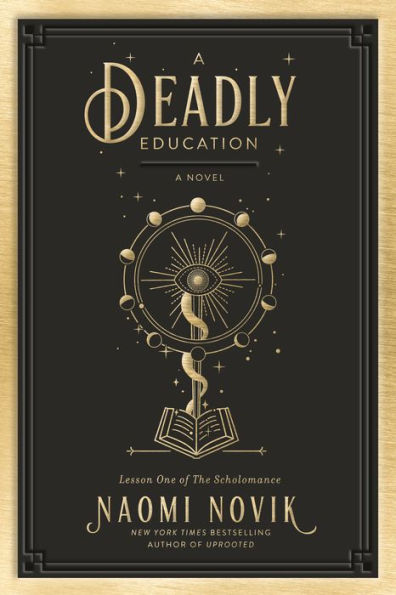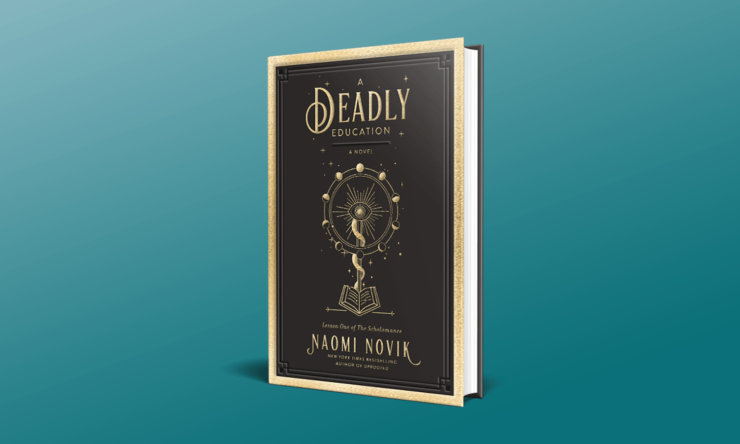El was born with an affinity for death and destruction. Though she may spend a great deal of time trying very hard not to suck up other people’s life source, she can’t even create a housekeeping or floor cleaning spell without ending up with something that can take out an army in one fell swoop.
She makes people feel like “it’s about to rain”, and so has never formed any friendships in or out of school. The best she an hope for is to show some of her power in a nonthreatening way and form an alliance strong enough to get her to graduation—and in Naomi Novik’s A Deadly Education, graduating from the Scholomance simply means making it out alive.
The school is set up to make the students fail (read: die), with a physical a connection to the abyss from where a constant onslaught of terrible demons and monsters make their way into the school to feast on students. El is surviving, when she isn’t forcibly helped by a hapless hero classmate named Orion, who slays every creature that comes his way, and many that do not come his way at all. This has caused an issue within the school though, because so many students are “not meant to all survive, anyway. The school has to be fed somehow”. The school, we are told, was set up to ensure that only the fittest (read: most privileged) survive. Why a global society of sorcerers with unimaginable power in their hands cannot work out how to protect their children instead of sacrifice them is unclear.
Magic, in A Deadly Education, must come from somewhere. Where it comes from, is dependent on the sorcerer casting the spell. El’s mother is as good as a good white witch can be—helping everyone, whether magical or mundane, giving away spells for free, never hurting a living thing for any reason, let alone for power. And so, as a balance, El is born “the exact opposite of this paragon”—”Some sorcerers get an affinity for weather magic, or transformation spells, or fantastic combat magic like dear Orion. I got an affinity for mass destruction.” But, as she tells us in one of the earlier bits of (very) frequent exposition, it is not possible to act out your spells without consequences. “It takes power and lots of it.” Power comes in two forms—mana “life force or arcane energy”, which you can build, and malia, where the power used comes from something alive—something as small as ants in your back yard, or as big as the person next to you. Those who use malia too often start to change, ‘rotting on the inside’ within years of graduating, though maleficers of this sort make it out of the Scholomance easily.
Buy the Book


A Deadly Education
It’s not hard to read the real world parallels into the world building of A Deadly Education—if you come from privilege, if you’re willing to borrow a little power from the dark side, your chances of success are automatically higher. Like in any fancy boarding school, the kids from a certain magical enclave (read: socio-economic background) connect with each other right away, regardless of whether they may get along or not. Their parents know each other, they’ve been taught to look out for each other, and they all have an allowance to tap into a massive wealth of power stockpiled for them to draw on when in need.
The Scholomance is where the entire novel takes place. It makes for an appropriately claustrophobic, constantly tense ambience, but it also means that a great deal of exposition is required to tell us about the outside world—what it is, why it needs the Scholomance, who set the school up and how it works. El tells us a great deal of this, quite often and with her trademark charm (read: unrelenting one dimensional snark).
In fact, there are too many info dumps in general and while they may be amusing, this is not enough to not notice the masses of exposition. El is prickly, angry and sarcastic, and it’s not always clear why she needs to be quite so dramatic in her disdain for everyone around her, especially since she needs to form an alliance to get out alive, but without taking out half her classmates in a show of power. Sure, she’s developed this bad attitude as a result never being liked, but she does very little to help her cause, even if her cause is just to survive. What really brings El to life though, is when she does eventually let her guard down, and start to form friendships.
The Scholomance’s student body is just as diverse as any international boarding school’s would be, if there was just one boarding school in the world—which in this case, there is. All the kids learn how to survive being hunted and eaten alive by forming the right sort of power alliances—just like in corporate life, really.
What’s odd is how we are told where each character is from, and what language they speak. It feels a bit forced, because most of them do not seem to have any other defining characteristics, other than being “the mandarin speakers”, or the Arabic speaking kids, or from the Dubai enclave. But perhaps that’s a version of reality too, since a great many of us who aren’t white are often essentially seen as just our colour, language, or nationality. What Novik’s intent with this was, is unclear, because it mainly seems like a way to check off what appears to be a diversity requirement in contemporary fiction.
For many POC readers (particularly desi readers, myself included), there will be some discomfort at reading about El’s familial background, and why she isn’t in touch with her father’s family. Her Welsh mother escaped the Scholomance alive and pregnant, while her Indian father died at graduation. Her father’s family first seem like the perfect people to take in El and her glowing good witch mother, working only with mana and never so much as eating meat let alone drawing the life source of another living creature, they turn turn out to have murderous intent once they meet 5 year old El, and her great grandmother has a premonition of her bringing massive doom to the world. El’s mother takes her and leaves permanently. This is awkward—if for no other reason then because there are so many cliches of mixed race kids being not being accepted (or worse) by their more conservative (read: third world) side of their families.
A Deadly Education may be making a commentary on predetermined societal class structures, but seems less intent on getting things right, then on being entertaining in an almost trendy way. Novik’s caustic and rebellious young protagonist is sure to appeal to a great many readers, though just as many will be thrown off by both her and the ‘soft diversity’ approach to what is vastly different from Novik’s last two books.
A Deadly Education is available from Del Rey.
Mahvesh loves dystopian fiction and appropriately lives in Karachi, Pakistan. She writes about stories and interviews writers for the Tor.com podcast Midnight in Karachi when not wasting much too much time on Twitter.










